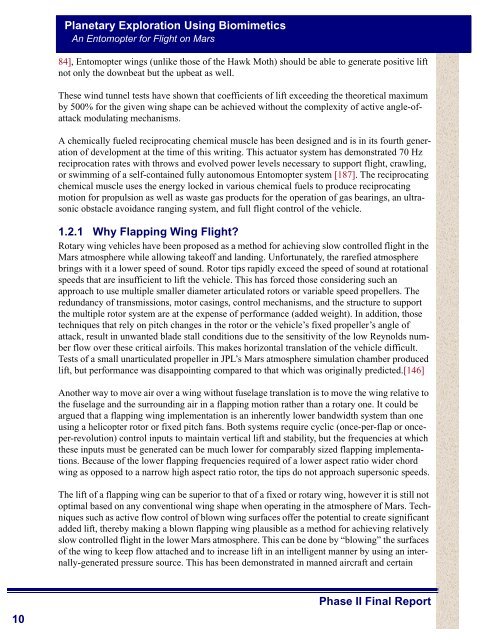Phase II Final Report - NASA's Institute for Advanced Concepts
Phase II Final Report - NASA's Institute for Advanced Concepts
Phase II Final Report - NASA's Institute for Advanced Concepts
You also want an ePaper? Increase the reach of your titles
YUMPU automatically turns print PDFs into web optimized ePapers that Google loves.
Planetary Exploration Using Biomimetics<br />
An Entomopter <strong>for</strong> Flight on Mars<br />
84], Entomopter wings (unlike those of the Hawk Moth) should be able to generate positive lift<br />
not only the downbeat but the upbeat as well.<br />
These wind tunnel tests have shown that coefficients of lift exceeding the theoretical maximum<br />
by 500% <strong>for</strong> the given wing shape can be achieved without the complexity of active angle-ofattack<br />
modulating mechanisms.<br />
A chemically fueled reciprocating chemical muscle has been designed and is in its fourth generation<br />
of development at the time of this writing. This actuator system has demonstrated 70 Hz<br />
reciprocation rates with throws and evolved power levels necessary to support flight, crawling,<br />
or swimming of a self-contained fully autonomous Entomopter system [187]. The reciprocating<br />
chemical muscle uses the energy locked in various chemical fuels to produce reciprocating<br />
motion <strong>for</strong> propulsion as well as waste gas products <strong>for</strong> the operation of gas bearings, an ultrasonic<br />
obstacle avoidance ranging system, and full flight control of the vehicle.<br />
1.2.1 Why Flapping Wing Flight?<br />
Rotary wing vehicles have been proposed as a method <strong>for</strong> achieving slow controlled flight in the<br />
Mars atmosphere while allowing takeoff and landing. Un<strong>for</strong>tunately, the rarefied atmosphere<br />
brings with it a lower speed of sound. Rotor tips rapidly exceed the speed of sound at rotational<br />
speeds that are insufficient to lift the vehicle. This has <strong>for</strong>ced those considering such an<br />
approach to use multiple smaller diameter articulated rotors or variable speed propellers. The<br />
redundancy of transmissions, motor casings, control mechanisms, and the structure to support<br />
the multiple rotor system are at the expense of per<strong>for</strong>mance (added weight). In addition, those<br />
techniques that rely on pitch changes in the rotor or the vehicle’s fixed propeller’s angle of<br />
attack, result in unwanted blade stall conditions due to the sensitivity of the low Reynolds number<br />
flow over these critical airfoils. This makes horizontal translation of the vehicle difficult.<br />
Tests of a small unarticulated propeller in JPL’s Mars atmosphere simulation chamber produced<br />
lift, but per<strong>for</strong>mance was disappointing compared to that which was originally predicted.[146]<br />
Another way to move air over a wing without fuselage translation is to move the wing relative to<br />
the fuselage and the surrounding air in a flapping motion rather than a rotary one. It could be<br />
argued that a flapping wing implementation is an inherently lower bandwidth system than one<br />
using a helicopter rotor or fixed pitch fans. Both systems require cyclic (once-per-flap or onceper-revolution)<br />
control inputs to maintain vertical lift and stability, but the frequencies at which<br />
these inputs must be generated can be much lower <strong>for</strong> comparably sized flapping implementations.<br />
Because of the lower flapping frequencies required of a lower aspect ratio wider chord<br />
wing as opposed to a narrow high aspect ratio rotor, the tips do not approach supersonic speeds.<br />
The lift of a flapping wing can be superior to that of a fixed or rotary wing, however it is still not<br />
optimal based on any conventional wing shape when operating in the atmosphere of Mars. Techniques<br />
such as active flow control of blown wing surfaces offer the potential to create significant<br />
added lift, thereby making a blown flapping wing plausible as a method <strong>for</strong> achieving relatively<br />
slow controlled flight in the lower Mars atmosphere. This can be done by “blowing” the surfaces<br />
of the wing to keep flow attached and to increase lift in an intelligent manner by using an internally-generated<br />
pressure source. This has been demonstrated in manned aircraft and certain<br />
10<br />
<strong>Phase</strong> <strong>II</strong> <strong>Final</strong> <strong>Report</strong>

















